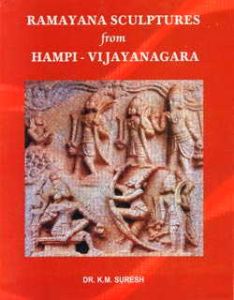
Contents: Preface. Abbreviations. 1. Introduction. 2. Site. 3. Historical perspective. 4. Temple architecture, style and Ramayana scenes on the pillar and walls of temples. 5. Conclusion. Bibliography. Index.
"The Ramayana is one of the two great epics of India and its influence on the life of Indian people has been great and immeasurable. The ideals of the Ramayana have gone deep into the core of Indian life and have largely moulded its social, political and cultural fabric and eternal history of India. Rama is an ideal hero and the Ramayana describes his character unparalleled in human history.
During Vijayanagara period many poets ad scholars translated the Ramayana in Kannada language. The most important work in Kannada on Ramayana theme is the Ramakatha of Narahari, datable to circa 1580-1600, based upon the Valmiki's Ramayana. He lived in the village temples at Pattadakal. The Papanatha Temple represents the Rama story begins with the Putrakameshti of Dasaratha and all the scenes bear labels in Kannada language of 6th-7th, century A.D. The important episodes are Rama's fight with Khara and Dushana, Surpanakha lamenting and also instigating Ravana to take revenge on Rama, the construction of the bridge over the sea, the fight between Vali and Sugriva and between Ravana and Jatayu as well as in Virupaksha Temple at Pattadakal have served as the inspiration for the more mature and better designed depiction of the themes on the walls of Kailasantha Temple at Ellora. The Mallikarjuna Temple at Pattadakal depicts the search of Rama and Lakshmana for Sita and Rama's cry at her separation. The Virupaksha Temple at Pattadakal, contains a large number of Ramayana scenes in narrative style, include Surpanakha's adventure in the cottage of Rama, Rama's battle with Khara and Dushana, Surpanakha lamenting before Ravana, Rama shooting the golden deer, Ravana carrying away Sita, Jatayu's fight with Ravana, the meeting of Rama and Sugriva, Vali-Sugriva duel, Sita in the Asoka Vana and Hanuman meeting her, Hanuman seated on an elevated seat made up of the coils of his tail etc.
Ramayana scenes in the sculptures from the Hazara Ramachandraswamy Temple, the Vitthalaswamy Temple and Brahma Vitthala Temple at Hampi and compared with Valmiki and other Ramayana stories."